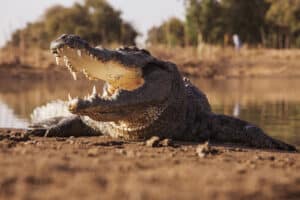Continue reading for our analysis...

The leopard is a solitary and versatile hunter that is able to make the most of many habitats. When it comes to diet, leopards will eat a wide range of prey and this has allowed them to survive threats to their habitats.
Leopards are carnivores and their staple diet is made up of medium-sized animals such as deer and warthogs. They hunt by creeping up on the animals and ambushing them. The distinctive spotted coat helps with this because it provides excellent camouflage.
However, leopards will also eat carrion and are quite happy to help themselves to prey that has been caught by another animal. That’s a great plan as long as the animal that caught the prey is no longer in the area or does not mind sharing.
Unfortunately, this particular leopard thought that they could help themselves to a carcass that was being closely guarded by a croc and they soon find out that this was a big mistake. Crocodiles do not like to share!
Leopard’s Habitat and Behavior

Leopards are found in many mountainous, grassland, and rainforest regions of Asia and
Africa
.
©Mohamed Hakem/Shutterstock.com
Leopards are found in many mountainous, grassland, and rainforest regions of Asia and Africa. In sub-Saharan Africa, their population numbers have been affected in the past by trophy hunting. Also, their opportunistic approach to hunting has resulted in them coming into conflict with their human neighbors.
They are considered pests by local farmers because they rarely fear people and steal livestock. The local population also regards them as a source of meat and fur.
This has changed in recent years. The increase in the tourist industry has brought wealth into the area and leopard-watching is a big part of this! As a result, local people are more likely to want to protect the leopards so that they will continue to attract wildlife enthusiasts.
Where Do Leopards Live?
The leopard is found in a variety of different habitats across sub-Saharan Africa and southern Asia. There are also small and isolated populations of leopards inhabiting remote geographic locations in the Far East, Northern Africa, and Arabia. The area must have a good source of cover and an ample supply of food, which can include tropical rainforests, tree-lined savannas, barren deserts, and mountain highlands.
Leopards have adapted to the growing presence of people and are known to both live and hunt in areas close to urban activity, with minimal interactions and disasters with humans.

Leopards tend to live for between 10 and 15 years in the wild.
©iStock.com/UrmasPhotoCom
How Long Do Leopards Live?
Leopards tend to live for between 10 and 15 years in the wild, depending on the habitat and the food supply available. Males tend to live solitary lives except when mating, while female leopards’ range tends to overlap their mothers. There is no distinctive breeding season with females being able to reproduce every couple of months. However, cubs often stay with their mothers for 18-plus months.
Is It Normal For Leopards To Eat Carrion?
Because they are obligate carnivores, leopards do not need to eat anything but meat. They are also opportunistic animals. While they can hunt and are very good at it, they won’t pass up a free meal that is just sitting out without any takers. They prefer medium-sized game but they won’t say no to anything smaller — or bigger!

Saltwater
crocodile
on the shore
©Firepac/Shutterstock.com
Crocs Guarding Their Kill
According to the video notes, this footage was shot at the Kruger National Park in South Africa at the Ngobeni Loop in the H14 sector. It is a well-known leopard-spotting area and on this day it did not disappoint.
This incredible footage gives us a close-up view of the leopard repeatedly trying to take the kill from the croc. The big cat approaches the water several times but has to retreat as the crocodile opens its enormous jaws and snaps. The leopard hisses in frustration but does not take on this huge reptile.
Crocodiles have the speed and power to cause nasty injuries to leopards that are foolhardy enough to get close to them. It’s obvious that this croc is not willing to share their meal!
Is it Normal for Crocodiles to Guard their Prey?
It is normal behavior for crocodiles to stash their food after a kill. Crocodiles are sophisticated hunters and will guard their killed prey against other animals. Crocodiles don’t store their prey at the bottom of rivers or lakes, however, they do have what is known as a “bunker” with an underwater entrance with the outside of it above water. That way can they still breathe while storing their prey.
Additionally, the reason crocodiles store their prey is that it becomes easier for them to eat once it has started to decompose.

On average, the saltwater crocodile can live around 70 years old.
©Khalil Ahmed/Shutterstock.com
Where Do Crocodiles Live?
Crocodiles are saltwater creatures that are normally found in Africa, Asia, and Australia. Although crocodiles usually live in eastern areas, alligator species are found mostly in the U.S. and other parts of the Americas.
With that said, American crocodiles can sometimes be found in Southern Florida, Hispaniola, Cuba, and Jamaica along the Caribbean coast from Mexico to Venezuela.
How Long Do Crocodiles Live?
On average, the saltwater crocodile can live around 70 years old. Additionally, the Nile crocodile will usually live anywhere from 50 to 60 years old.
Although wild crocodiles can live a long lifespan in the wild. In captivity, crocodiles have been known to live 100 years old!
Crocodile vs Leopard: Who Would Win?
Though good at stalking its prey before pouncing, the leopard is no match for the larger crocodile. With its speed and weight, as well as its enormous mouth full of sharp teeth, it makes sense that the leopard would forfeit its easy dinner for its life.
Thank you for reading! Have some feedback for us? Contact the AZ Animals editorial team.






